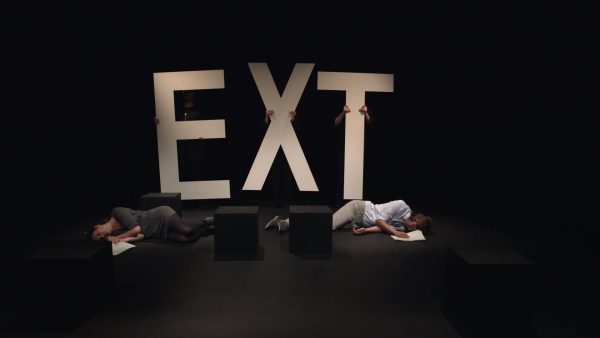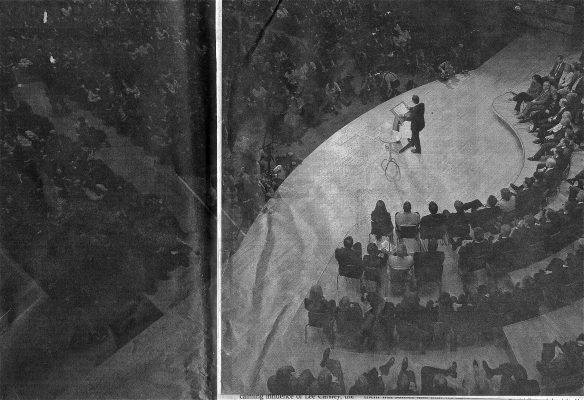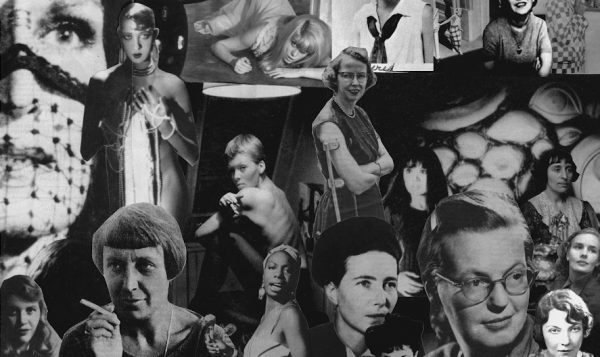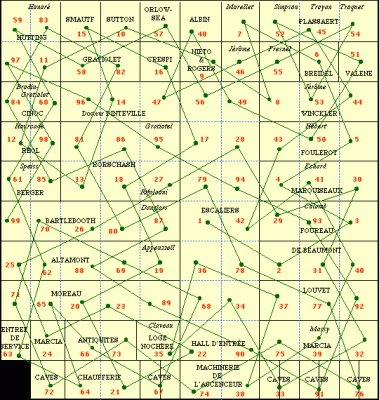It’s 1957 and the press release still isn’t written[1]
An actress dressed in black overalls stands on a theatrically lit soapbox, one hand pressed to her forehead as she reads from a script. Her monologue is abstracted from Hannah Arendt’s seminal text The Human Condition collapsed into manifesto speech, into melodramatic rhetoric visually punctuated by Pantomime style placards. The actress’s speech becomes increasingly fraught with anxiety as she frenetically occupies six oratory positions across the stage. To act, in its most general sense, means to take initiative, to begin, to set something into motion; yet here this performative promise is deliberately withheld. The actress reaches the end of her script drowned out by sound. Dissatisfied with her rehearsal, she picks up a broom, silently sweeps the stage floor, and puts on her coat and leaves. Accompanied by a live band, the performance is loud and exaggerated, a theatrical staging of the tension between solo performance and collectivity that is ultimately entirely anti-climatic. Despite the actress’s best efforts, the performance deliberately fails to arrive.
First realised at the ICA in March this year this work entitled Footnote 5: A Six Stage Manifesto on Action (2012) forms the fifth live installment of Collapsing in Parts (2012),a long-term project devised by the London-based artist Cally Spooner. Since graduating with an MFA from Goldsmiths in 2008, Spooner has been gaining increasing recognition for her unique examination of performance, which she articulates through the twin registers of the textual and the live. Her work has been presented across a wide range of platforms including solo exhibitions in London, Paris, Frankfurt and Berlin; alongside readings as part of Serpentine Gallery’s prestigious Memory Marathon; and a Merleau Ponty radio play titled Indirect Language realised in multiple locations including the virtual art centre Resonance FM. Spooner’s practice typically develops from personal research. Through a process of extensive reading and collecting of images, she creates narratives and scripts that she then develops into live works. In these live pieces, which have been variously conceived as performance lectures, plays, and a full-length feature film production, the private thinking inherent in Spooner’s writing is collectively actualised in the public realm. Through a process of constant revision her individual text and live event-based experiments inflect and inform one another together forming a unique body of work that examines performance in the broadest sense of the term. Spooner’s diverse output deserves substantial recognition for its radical re-articulation of what it means to work with the temporality of the live.
For the past year Spooner has been producing Collapsing in Parts – a solo exhibition at International Project Space, Birmingham conceived as a single, multi-part performance. The work in its initial form existed as a body of writing which Spooner published incrementally in eight parts online, each as it was written. Working together with a number of collaborators she then expanded this text into a series of episodically exhibited live events – pieces that she describes as ‘footnotes’ to the writings. The live footnotes and the text form a double narrative running through the work as it is created. This ambitious undertaking is typical of Spooner’s unique way of working – imaginatively researching and staging the concept of performance and its mechanisms through the textual and the live.
Spooner’s work toys with the possibility that incomplete performance and indirect language might be more constructive, more potentially generative, than conventional theatrical presentation and constructed rhetoric. This notion of a space of ambiguous irresolution is familiar of course, articulated perhaps most vividly in modernist theatre, in the existential stagnancy of Beckett’s Waiting for Godot in which ‘Nothing happens. Nobody comes, nobody goes.’ A space reconfigured as a zone of critical potentiality in the 1960s and 1970s in the neo avant-garde’s notion of the open form. Yet Spooner’s practice is situated in a specifically twenty first century territory; in a radical rethinking of the concept of performance, her work expands beyond existing ideas of performance art per se in which art criticism is currently heavily involved. Casting aside historical preoccupations with performance as an aesthetic discourse on what it means ‘to be’, along with more recent discussion of the socio-political implications of the move from the traditional subject to object relation to an art of inter-subjective encounter; instead she critically reflects on performance in the broadest sense of the term. Spooner’s work challenges the notion of performance as a promise: to deliver, to arrive, or to achieve.
Soon to be published as a single novella the textual element of Collapsing in Parts is structured around three protagonists who each fail to perform due to their own self-obsessive neuroses: a screenwriter with nothing to write, a professional golfer who has lost his competitive drive, and a politician more concerned with his appearance than his constituents. ‘Their stories are intermittently interrupted by a the character of the Copy Editor whose comments on poor spelling, bad planning, and socio-political progress prohibit the narrative from really getting anywhere,’ Spooner explains. A combination of dialogue and crafted prose, this body of writing explores notions of progress, productivity, and the urge to perform both in society and in the work place – recurring themes in Spooner’s production to date. For instance, Seven Thirty Till Nine (2012) presented at Shanaynay, Paris earlier this year, consisted of a jobbing jazz pianist temporarily employed for an hour and a half each evening to play a set list of hits doctored with Spooner’s own maverick lyrics in an otherwise empty gallery configured as a bar. Featuring a reworking of Tina Turner’s What’s Love got to do with it? humorously transformed into a song about labour and immaterial production, the work investigates these themes through asking what it means to be hired to perform in a space in which one’s skills and work will inevitably be ignored.
Conversation with Spooner often returns to thinking about production and the best way of working. Whilst her writing is a solitary practice developed alone, the ‘live testing’ happens through collaborative endeavor. Between 2006 and 2010 Spooner worked as a producer, often making pop videos. I suggest that artists and curators could learn a lot from the film production unit as a means of collaborative production, she agrees:
‘It’s a massively important mode, and I know on one hand, it’s just a method of getting something made, but I’m also really interested in how each person is clearly and individually responsible for the thing they can do well in such working arrangements. Especially when you’re shooting, say, a music video, in one long day, you really experience this coming together of different skills and people, who might not necessarily know each other, or might not have worked together before, but because they all have a role – a thing they do and do well, a new production gets made very quickly by this temporary group, who disassemble and work elsewhere, after the work is done. I think these means of production can enable those working to perform well, which can be very satisfying. And I think that’s to do with having a role that you can speak of, understand and take responsibility for.’
The culmination of Collapsing in Parts is in fact a full length feature film – a significant departure from her previous live output to date, which has predominately been staged for a live audience. Yet despite this shift in the temporality of the work’s making away from a simultaneous production and presentation, she describes the piece as ‘the first really live work’ she’s ever made. Currently untitled, the film was shot in a single straight take and is entirely free from post-production and editing. Mostly silent and visually sparse, the film is predominately composed of an unscripted, undetermined emptiness punctuated with frenetic bursts of language. A logical extension and product of the novella, the film forms a ‘landing point’ of the Collapsing in Parts performance – the anti-climax of eight months worth of writing.
Whilst scripting the film Spooner began making a body of pieces entitled I’ve been Ill Advised by My Scriptwriter (2012) which includes an ongoing series of works on paper: simple collages made up as c-types each featuring a US President performing a single gesture beyond the remit of political protocol and relating to the drama of performance in some way. Nixon is depicted petting a lion, Carter encountering a clown, Regan taking off a top hat and so on. Each gesture is carefully abstracted from its original photographic context and presented as an isolated fragment of an action floating in an empty pictorial plane. Presidents of course never write their own speeches, rather they are highly scripted and crafted with care. A presidential speech denotes representation and rhetoric – constructed language in essence. These isolated gestures then return us to something at the heart of Spooner’s artistic practice – to her concern with the relation between performance and language. Paradoxically these studio-made, pictorial works foreground an essential quality of Spooner’s live work. Her presidents’ gestures tacitly speak to Spooner’s parallel interests in the stasis of action and the movement of language. At the level of both its production and presentation her practice is structured in dialogue and in the movement of thought as opposed to the making of fixed forms. It is important for Spooner that it be emphasised that she generally works not with actors but with friends, students and colleagues with whom she is dialogically engaged. This methodology functions as a means of ‘destabilising her own position’ enabling a co-operative process of constant revision that in today’s art climate is refreshingly altruistic.
Spooner’s understanding of the nature of speech, of everyday conversational language as indirect is interrelated to the notion of non-arrival so central to her work. The idea of not being able, and importantly not needing to settle in a definite space is key to her unique understanding of performance. Utilising the live as both a testing ground, and structural frame, she reconfigures liveness as a working method. Through the orchestration of discordance, Spooner sets up live structures that enable something to happen or not. Spooner’s characters may never get their act together, but that’s precisely the point: ‘I accept the challenge to operate under the same terms of high performance, as expected of anyone working today, but don’t want anything to happen. I think it’s the way to preserve the live, to look after it properly’.
Spooner’s interest in indeterminacy arises from this belief in the need to think and utilise the live as a space of indefinite experimentation. For Collapsing in Parts, Spooner’s research led her to seek out indeterminate forms, such as B.S Johnson’s The Unfortunates, an unbound book of twenty-seven chapters that can be read in multiple orders. Open form musical scores also became an important reference point, in particular the work of Earle Brown, the American jazz musician and composer who established his own formal and notional systems creating scores that could be read in any direction and played at any tempo. In a recent interview Spooner explained the significance of Brown to the project:
‘Even though his works are improvisational, they depend on fixed structures as notated in his scores; this stable framework can provoke countless variations and possibilities. Through these structures, I’ve been thinking about alternative models of organization that have been tailored to heighten creative aptitude and production. In the case of Collapsing in Parts, my stable score is The Human Condition. It provides a textual framework in which a number of people, including actors and friends, can perform and deliver different pieces of work relating to my understanding and application of Arendt’s ideas.’
In The Human Condition Arendt defines action as a mode of human togetherness, as a form of participatory democracy, ‘the one miracle-working faculty of man’. It is fitting then that Collapsing in Parts has settled in film: a collaborative means of thinking through liveness without actually meeting the conditions of a live event, and a mode of resistance to high performance in which each individual in the production unit must highly perform. In shifting the focus of performance away from immediacy and raw presence to the live as a space of constructive refusal and method of making, what is at stake in Spooner’s work is the importance of the live as a space of inconclusivity. The performance may be forever pending, but the live is inherent in its production.
[1] Title of a piece Cally Spooner made in 2011, a live press release for an exhibited she curated through reading and conversation at the WCW Gallery, Hamburg. The work formed Footnote 3 of Collapsing in Parts.





